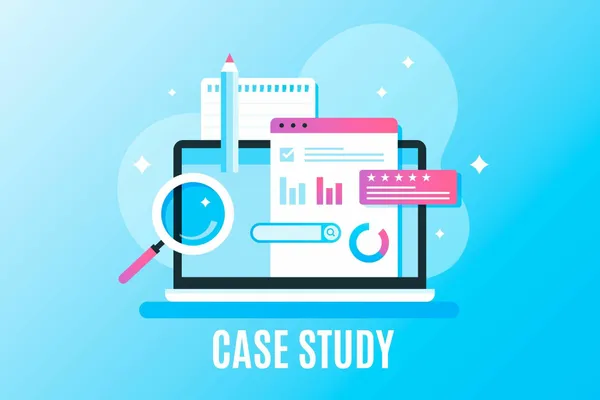Choose the right topic and client
The first step to creating an effective case study is choosing the right topic and client. These decisions will determine the power of your story. Think about the challenges that most often plague your potential clients. This could be, for example, increasing sales, improving process efficiency or optimizing costs. Choose a topic that solves a real problem and presents measurable benefits.
Another thing is choosing the right client for the case study. Choose a company that has achieved impressive results with your product or service. The more spectacular the results, the better! But remember that this is not about empty bragging. Choose a client who is representative of your target group and can serve as a real example of success.
Before you start creating a case study, make sure that the selected client agrees to share their story. This is absolutely crucial! Without this consent, nothing will happen. Present the benefits of the case study to the client - it is a great opportunity to promote them as well. But respect their decision if for some reason they do not want to participate.
Choose a story that solves a specific problem, impresses with results, and is a "yes" from the customer themselves. Stick to these principles, and your case study will have a strong foundation. In the following parts of the article, you will learn how to conduct an interview with the customer and what questions to ask to squeeze the most out of this story. Keep your finger on the pulse!
How to interview a client to obtain valuable information?

Before you call a client or schedule a meeting, prepare a list of questions. Think about what you want to achieve through a case study and what information will be most convincing to potential clients. Ask about the challenges the company faced before using your solution. Find out how the implementation process and cooperation with your team went. And most importantly - what results were achieved thanks to your product or service.
During the interview, try to get the most detailed answers possible. Ask questions, probe the topic, don't settle for generalities. The more specifics, the better. If the client mentions an impressive result, ask for the exact data and permission to use it in the case study. Remember that numbers and percentages make an impression and build credibility.
It is best to conduct the interview in person or over the phone. Direct contact promotes a free conversation and allows for asking additional questions. If possible, record the conversation (of course with the client's consent). This way, you won't miss any important details. If recording is not an option, take detailed notes. After the interview, immediately write down the most important information while it is fresh in your mind.
Remember that an interview is not an interrogation. Create a pleasant atmosphere, show interest and gratitude for the time spent. Treat your interviewee as a partner, not as a quoting machine. This will not only gain you valuable information, but also the client's sympathy, which will pay off in the future.
So let's get to work! Prepare questions, arrange an interview and be surprised at how much you can learn during an honest conversation. And once you have collected the material, it's time to give it the right structure. You will learn how to do this in the next part of the article. Take a deep breath and let's go!
Case study structure - what to remember?
Start with a title that will catch the eye and summarize your main achievement. Don't be afraid to be specific and impressive! For example: "How Company X Increased Sales by 200% with Our Software" - such a title will immediately intrigue and impress potential customers.
In the introduction, introduce the hero of the case study - your client. Describe their industry, company size and key challenges they faced before using your solution. It is important that the recipients can identify with the client's problems and think, "Hey, this sounds familiar! I wonder how they dealt with it."
The next part is a description of the implementation process and cooperation with your company. Show how your product or service helped the client overcome difficulties and achieve goals. Don't go into boring technical details, focus on the benefits and specifics. Emphasize what distinguishes your approach and why your solution turned out to be a bull's eye.
Now it's time for the tastiest morsel - presenting measurable results and benefits for the client. Here, the numbers speak for themselves! Show how much sales have increased, how much efficiency has improved, how much time and money the customer has saved. The more impressive statistics, the better. But remember to provide them in context and show real business benefits.
End the case study on a strong note - a quote from a satisfied customer that confirms the value of your solution. Nothing builds trust like a genuine recommendation from a real company. And at the end, add a call to action - encourage recipients to contact you and see for themselves how your product or service can help them achieve similar successes.
And remember - a case study is not a dry report, but an engaging story of flesh and blood. Make sure the form is attractive - use simple language, short sentences, subheadings, bullet points. Play with the form, add a bit of humor where appropriate. Above all - write with the recipient and their needs in mind, not to praise your product to the skies.
To summarize the section once again, the case study should include:
- Customer introduction
- Description of the cooperation process
- Results achieved
- Customer review
How to make a case study visually attractive?
First of all, focus on high-quality photos and graphics. People love images that catch the eye and tell a story. If your case study involves the implementation of a new system, show a photo of smiling employees using it. If you write about impressive results, present them in the form of an attractive chart or infographic. Remember, one picture often says more than a thousand words!
But be careful - don't overdo it with these decorations! Graphics should complement and illustrate the content, not distract from it. Take care of visual consistency, use company colors and fonts. And most importantly - check every time whether the graphics actually contribute something to the message or are just empty decoration.
Clarity of the system
Another issue is the readability and clarity of the layout. Don't throw text like peas against the wall! Use subheadings, paragraphs, bullet points - this helps readers to orient themselves in the structure and assimilate the content more easily. Use bold and highlighting to emphasize key information. And don't forget about "highlights" - empty space between elements that gives the eyes a rest.
Nowadays, people browse content on various devices - from smartphones to large monitors. Make sure that your case study looks good regardless of the screen size. Use RWD (Responsive Web Design) techniques to adapt the layout to different viewports. Take care of readability on small screens and comfort of clicking on touch interfaces.
CTA
Your case study is supposed to convince and convert, right? Don't forget about a clear CTA (Call to Action) that will encourage people to contact you. Let it be a visible button with a slogan like "Schedule a free consultation" or "Ask for an offer". And place it in a strategic place - preferably at the end of the case study or at a few key points.
Remember - visually appealing materials are easier to read, remember better and are more likely to be shared. And you want your case study to reach the widest possible audience, right? So take action - dazzle them with words and images, and the effects may surprise you!
How to promote your case study?
Okay, you've got a case study that impresses with its content and design. Congratulations! But that's only half the battle. Now it's time for the real challenge - to reach the widest possible audience. Because what's the point of creating a masterpiece if no one sees it? Exactly!

The first and absolutely basic thing - publish the case study on your website and blog. These are your most important communication channels, so they absolutely have to be on the list. But don't put it somewhere at the bottom of the page, let it be visible and easily accessible. It's best to create a separate "Case Studies" section in the menu and highlight it on the home page.
Share the link to the case study on your company profiles - LinkedIn, Facebook, Twitter, where only your clients are active. But don't just post a dry link - write an intriguing post that will encourage people to click. You can also create a graphic teaser or video preview to grab attention. And be sure to encourage the client whose story you described to share the case study too. Their network of contacts are potential clients!
Email marketing is another powerful promotion channel. Your subscribers are warm leads - people who already know you and are interested in your content. Send a dedicated newsletter with a link to the case study and a short introduction. You can also add a CTA to your regular mailings - something like "Check out how we helped company X achieve a 200% increase in sales". Sounds tempting, right?
Do you have any industry events planned - a conference, webinar, trade show? Use them to present your case study. You can do a presentation, a discussion panel or simply hand out printed copies. Face-to-face marketing works wonders, and case studies are a great tool for building credibility and acquiring leads.
But be careful - don't spam left and right, it will only put people off. Adapt your message to the channel and recipients. Linkedin is the perfect place for a longer, substantive post, and on Twitter it's better to go for a short, intriguing headline. In the mailing, give more context, and at the conference, focus on the key conclusions. And don't send the case study to everyone - target people who might actually be interested.
And remember - promoting a case study is not a one-time action, but a long-term process. Don't expect immediate results, build engagement step by step. Monitor statistics, collect feedback, optimize activities. And don't be afraid to reach for paid tools - promotion on LinkedIn, Facebook Ads, sponsored articles. Sometimes it's worth investing to reach the right people.
Case study promotion is a big challenge, but also a huge opportunity. A well-made and distributed case study is a machine for generating leads and building reputation. So create a promotion plan today, share it with your team and act consistently. Success is within reach!
Summary
Creating an effective case study is a process that requires careful planning and execution. Here are some key points to keep in mind:
- Choosing the right topic and client is the foundation of a good case study. Look for stories that solve real problems and present measurable benefits.
- Conducting a customer interview is a crucial step. Prepare well, ask specific questions and aim for detailed information and figures.
- The case study structure should be clear and logical. Start by introducing the client and their challenges, describe the cooperation process, present the achieved results and end with the client's opinion.
- Visually appealing form is just as important as content. Use high-quality graphics, ensure a clear layout and responsiveness, and don't forget a clear call to action (CTA).
- Promoting your case study is essential to reaching potential customers. Use a variety of channels, from your own website, through social media, to industry events.
Remember that a good case study is a powerful marketing tool. Investing time and effort into creating and promoting it can bring tangible benefits in the form of new leads and strengthening your brand's position on the market.
Frequently asked questions
How long should a case study be?
There are no hard and fast rules, but most often, effective case studies are between 500 and 1,500 words long. The most important thing is to include all the key information, but without unnecessary rambling.
Can I create a case study without the client's consent?
Absolutely not. You must always obtain the customer's consent to use their history and data. Without it, you expose yourself to legal problems and loss of trust.
How often should I create new case studies?
It depends on the specifics of your industry and the pace of your company's development. A good practice is to create at least 2-4 case studies per year, but if you have interesting projects, you can do it more often.
What information should I keep confidential in a case study?
Always consult with the client on what information may be made public. Avoid disclosing financial details, personal information, or trade secrets unless you have express permission to do so.
Can I use one case study in different formats?
Yes, that's a great idea! From one case study you can create a text version for a website, an infographic for social media, a presentation for a conference or even a short film.
How to measure the effectiveness of a case study?
You can track views, time spent on the page, downloads (if you offer a PDF version), but the most important thing is the leads generated by the case study. You can also ask new clients if they have read your case studies before deciding to work with you.
Is it worth creating case studies for small projects?
Yes, if the project has produced interesting results or solved an unusual problem. Sometimes smaller projects can be more relatable to potential customers than large implementations.
How often should I update existing case studies?
It’s worth reviewing them at least once a year. Update the data if the client has achieved new results, refresh the visual form if it looks outdated. You can also add new sections, such as those about the long-term effects of cooperation.

Adam Naworski



